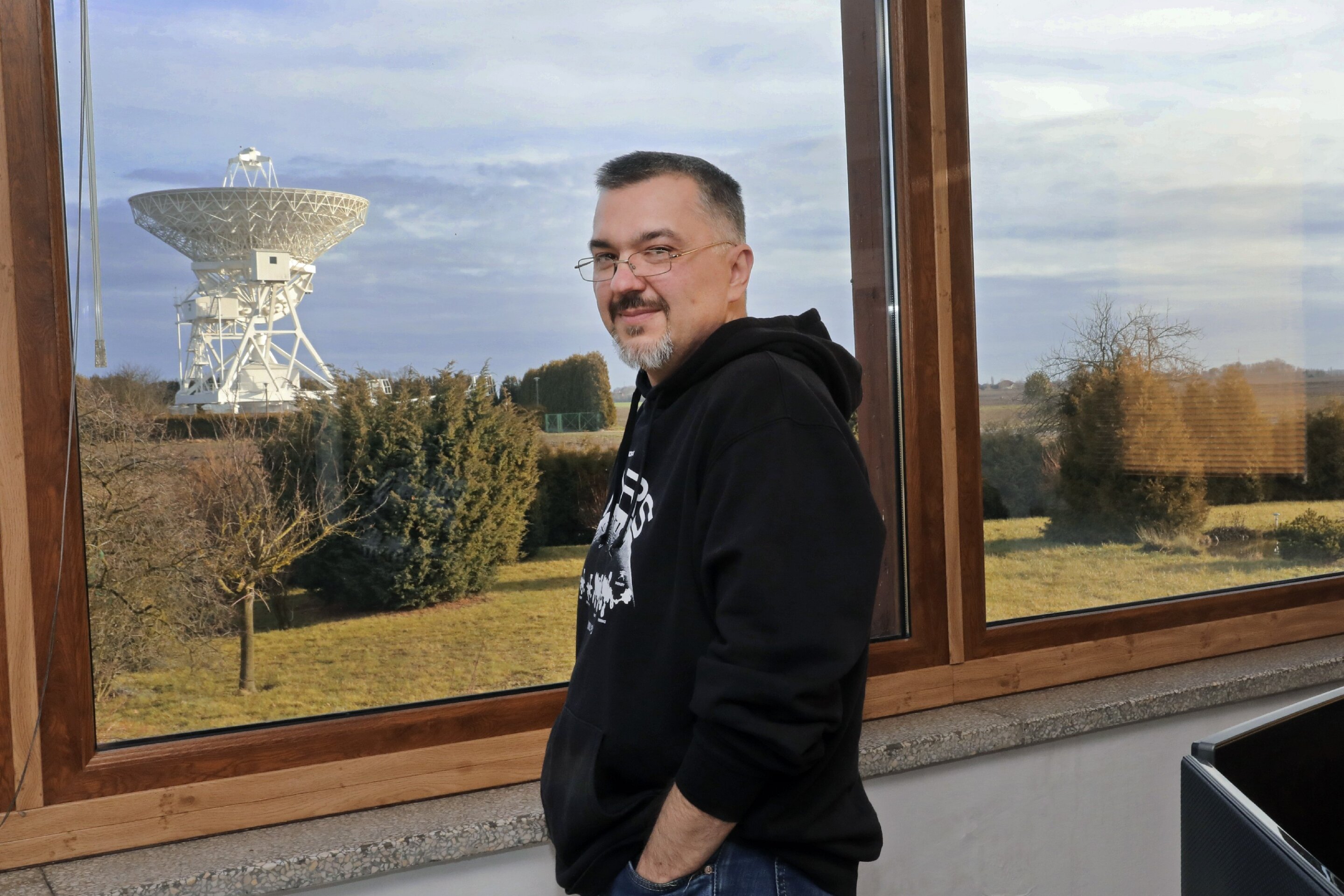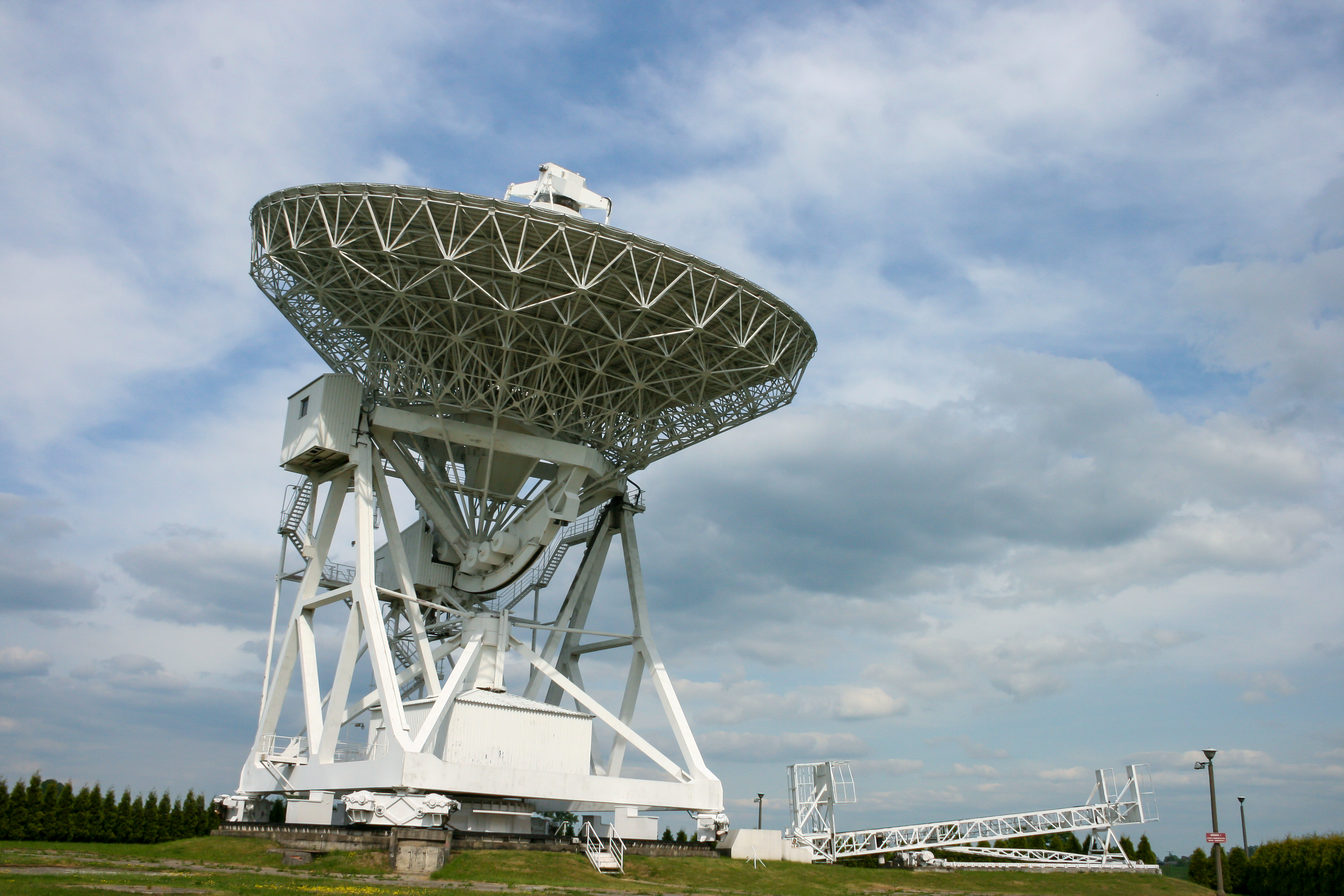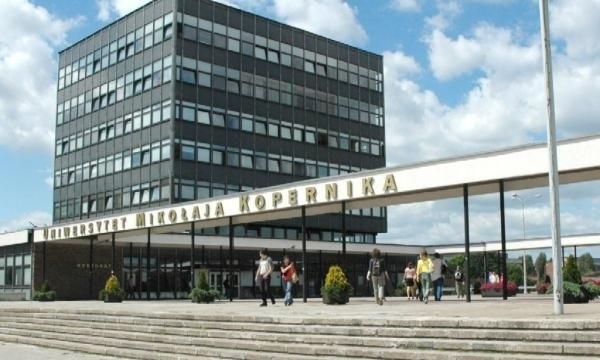
From Nicolaus Copernicus University[Uniwersytet Mikołaja Kopernika w Toruniu] in Toruń(PL)
February 23, 2022
Żaneta Kopczyńska

Dr. Marcin Gawronski from the Institute of Astronomy at the Faculty of Physics, Astronomy and Informatics Nicolaus Copernicus University. Credit: Andrzej Romanski/NCU, Torun,Poland.
The phenomenon of fast radio bursts is one of the greatest mysteries of modern astrophysics. Until now it has been believed that their source is magnetars. The latest discovery, in which dr Marcin Gawroński from the NCU Institute of Astronomy played a large part, may partially revise this view.
The fast radio bursts (FRBs) are millisecond-long bursts of radiation recorded on radio waves. They are extremely powerful—for example, during one of the brightest flashes lasting five milliseconds, as much energy is radiated as our Sun generates in a month. The scale of the phenomenon is difficult to imagine.
The first radio bursts were “discovered” barely 15 years ago. Until April 2020, all the FRBs observed by astronomers came from cosmological distances of hundreds of millions of light years. It was only two years ago that they also managed to track flashes originating in our Galaxy. It is important to note that due to the equipment and associated sensitivity limit, researchers are only able to observe the most luminous objects in the Universe, the most powerful bursts.
“FRBs are currently one of the hottest topics in contemporary astrophysics. Discovered accidentally in 2007 during a review of archival data, and currently under intensive observation, they are still a great mystery,” explains dr Marcin Gawronski from the Institute of Astronomy at the Faculty of Physics, Astronomy and Informatics Nicolaus Copernicus University (Torun, Poland). “The results gathered so far make it possible to divide the FRB phenomena into different classes, but we still have not found out whether they are emanations of one or many separate physical processes.”
Cosmic catch
Researchers are not 100 percent sure what causes the bursts. Astrophysicists have various hypotheses that could explain their formation, including the existence of extraterrestrial civilisations. However, so far magnetars have been considered to be the source of FRBs.
“Magnetars are neutron stars with extremely strong magnetic fields, they are formed after supernova explosions” says dr Gawronski. “So far, scientists have agreed that they are responsible for the FRBs. Why? Because in order to produce an FRB, it is necessary to have a huge amount of energy, which can be quickly released and used in various processes. The only sources of this type known to us are either the magnetic fields of a cluster of neutron stars—these magnetars—or the gravitational energy of black holes.”
Although astronomers agree that fast radio bursts are the result of violent processes occurring in the immediate vicinity of highly magnetized neutron stars, it is still unclear why most of them appear as single signals, while other sources can be observed on radio waves repeatedly. In some cases, the bursts are additionally characterized by periodic activity, i.e., they occur at regular time intervals. This, however, only helps in planning observations.
There are also quite a few difficulties that astronomers have to deal with in FRB observations. “Studying FRB activity is very difficult because flashes are random phenomena. It seems a bit like fishing—we cast a fishing rod and wait. So, we set up radio telescopes and we have to wait patiently,” says dr Gawronski. “Another problem is that radio telescopes ‘see’ quite a large field of the sky, e.g., ours in Piwnice covers an area half the size of the Moon’s disk in the radio band, which we usually use for FRB observations. There are many objects over such a large area, so it is difficult to pinpoint one particular flash. Another issue is the enormous amount of data that we collect during such observations—we can record up to 4 gigabits of data per second, so we need very large storage capacities. So, we have to process, analyze and delete this data on an ongoing basis to make room for the next.”
As you can see, there are many puzzles and difficulties connected with fast radio bursts. Astrophysicists are working on models to explain this phenomenon, but the recent discovery, in which dr Marcin Gawroñski also participated, brings yet another mystery to be solved.
Cosmic inquisition
Last year an international group of astronomers, including dr Gawronski, pointed radio telescopes towards the galaxy Messier 81.
“It is a huge and close to us galaxy, similar to the Milky Way—it is located about 12 million light years away from us, in summer when the weather is good you can see it with a regular set of binoculars, and e.g., with the Hubble telescope you can observe single stars in it,” explains Dr. Gawronski. “Canadians from the CHIME project told us that there was a source of fast radio bursts in the vicinity of this galaxy, and what’s more, some of its properties indicated that this object was related to the Messier 81.

We thought it would be a great opportunity to try to find out what specifically generated the FRBs.”
The observations were made by researchers working primarily in the PRECISE consortium.
“This is a team of researchers whose main objective is to locate FRB sources, estimate the distances to them and study the properties of the environment in which FRBs are placed. In this way, we can try to say something about the evolution of the sources of fast bursts and the very processes in which FRB objects are generated,” says dr Gawronski. “In a sense, we act in parallel to EVN (European Very Long Baseline Interferometry Network—editor’s note), as we try to gather European radio telescopes outside the time allocated for standard observations within this consortium, to which, of course, the NCU Institute of Astronomy belongs together with the RT4 radio telescope.”



The Torun RT4 radio telescope, at the Toruń Centre for Astronomy, Toruń, Poland. Mike Peel (http://www.mikepeel.net).
The researchers are very lucky. The first time they pointed their radio telescopes at the vicinity of the Messier 81 galaxy, they found a series of four bursts. It wasn’t long before they caught two more. However, the new findings came as a surprise to the researchers.
“When we saw the first results, we could not believe it, and at first, we even thought that we had made a calculation error. It turned out that we had not. It was like in the Monty Python’s sketch Nobody expects the Spanish Inquisition. Because none of us expected such a thing,” says Dr. Gawronski.
A young one among the old?
Firstly, the burst came from a globular cluster. So, the first disappointment came at the beginning—a cluster of this type consists of a huge number of densely packed stars, so it was impossible to pinpoint the specific object that was the source of the FRB, even with the help of the Hubble orbiting telescope. More interestingly, globular clusters are composed of very old stars, formed up to 10 billion years ago—they are the oldest star systems in the galaxies. It is therefore futile to look for “young” magnetars there.
“Many questions came to our minds: where did the magnetar come from there? We assumed that it must have been the source of the bursts. In fact, the magnetar could not have been there. And if it was, it could not have been formed in a classical way, i.e., following an explosion of a massive star,” explains dr Gawronski, “Such massive stars live for a very short time and within an estimated time of several tens of millions of years after their formation they end their lives in a very impressive phenomenon, called a supernova explosion. It is known that stars do not form in globular clusters for a long time, so no new magnetars can form there during a supernova phenomenon.”
If we reject the possibility that there are star wars taking place quite near us, in which planets are destroyed—and such a hypothesis may not be straight out of science fiction films, since many scientists take into account that FRBs may be technosignatures—then there are several other hypotheses.
“Theoretically, a new magnetar could have been born from an old star, or more precisely from the explosion of a white dwarf. Such a phenomenon can occur in a binary system, where a white dwarf slowly “eats” its companion and at some point, it exceeds the mass for which its stable structure can exist. Then this unstable dwarf explodes in a thermonuclear explosion, during which a neutron star may also be formed, such as a magnetar,” explains Dr. Gawronski. “However, it is not such a simple explanation: if there was a supernova explosion in a globular cluster (but of a different type than the death of massive stars), it must have happened not so long ago on a cosmic scale. According to current theories, magnetars are active for only a few million years after birth. The effects or remnants of such an explosion should be noticeable to us, but so far nothing has been observed.”
The other possible explanation is the merger of two compact, old stars—white dwarfs and/or neutron stars—and the formation of a young object in the so-called kilonova phenomenon. However, the chance of such an event occurring in our “local” Universe is rather slim.
The astronomers’ discovery is as interesting as it is mysterious. For now, one thing is certain—the bursts are the result of some as yet unrecognized phenomenon. The work of astrophysicists may contribute to its description and investigation. The results have been published in the journal Nature.
See the full article here.
five-ways-keep-your-child-safe-school-shootings
Please help promote STEM in your local schools.

Nicolaus Copernicus University in Toruń [Uniwersytet Mikołaja Kopernika w Toruniu] is located in Toruń, Poland. It is named after Nicolaus Copernicus, who was born in Toruń in 1473.
The first institution of higher education in Torun, the Toruń Academic Gymnasium was founded in 1568 on Piekary street. It was one of the first universities in northern Poland. The Academic Gymnasium was the precursor to scientific and cultural life (including the first museum created in 1594) in the region. Thanks to the efforts of Heinrich Stroband, city mayor in 1594, academics in Toruń received good working conditions for teaching and research. Among his professors in the seventeenth and eighteenth centuries were meritorious scholars of Polish and Prussian history, authors of textbooks and papers from various disciplines of humanities, and associates scientific journals.
The establishment of the university in a modern form began in the nineteenth century. During the partitions of Poland the Prussian government planned to create a University of Theology, which was to include faculties of law and economics, unfortunately this project did not materialize.
In the interwar period the city authorities of Toruń again sought to establish a university. Soon after the annexation of Pomerania to the reborn Poland in 1920, a new phase of efforts to develop the university began. Even before 1920 the Supreme People’s Council had considered the proposal to establish higher educational institutions in the Polish territories annexed by Prussia at the University of Gdansk and in Toruń. However, political developments and the uncertain future of Pomerania prompted the council’s leadership to accept the December 1918 resolution of the Sejm to overlook Toruń as a location for a new university and instead go ahead with the development of a university in Poznań.
In 1920, the first declaration requesting the establishment of a university was put forward in November by the National Workers Party whose members chose Toruń-born Nicolaus Copernicus to be the patron of the university. For this purpose a number of educational societies, such as the Baltic Institute (later transferred to Gdynia, and then to Gdańsk) amongst others, were established in the town.
Finally in 1938 it was decided to set up the Nicolaus Copernicus University in Toruń as a subsidiary of Poznań’s Adam Mickiewicz University [[Uniwersytet im. Adama Mickiewicza w Poznaniu](PL); work was to start at the beginning of 1940. This program, however, was interrupted by World War II. It was not until 1947, (two years after the creation of the Nicolaus Copernicus University) that prof. Karol Gorski revealed that before the outbreak of World War II there was an approved plan to open Poznań University long-distance division in Toruń in 1940, to teach the humanities and theology.
Faculties
Faculty of Biology and Environmental Protection
Faculty of Chemistry
Faculty of Earth Sciences
Faculty of Economic Sciences and Management
Faculty of Education Sciences
Faculty of Fine Arts
Faculty of Health Sciences
Faculty of History
Faculty of Humanities
Faculty of Languages
Faculty of Law and Administration
Faculty of Mathematics and Computer Science
Faculty of Medicine
Faculty of Pharmacy
Faculty of Political Science and International Studies
Faculty of Physics, Astronomy and Informatics
Faculty of Theology
In 2017, Times Higher Education ranked the university within the 801-1000 band globally.
International cooperation
University of Padua – Italy
University of Ferrara – Italy
Sapienza University of Rome – Italy
University of Oldenburg – Germany
University of Göttingen – Germany
University of Bamberg, – Germany
Universität Rostock – Germany
University of Greifswald – Germany
Bundeswehr University Munich – Germany
Université d’Angers – France
Nottingham Trent University – United Kingdom
Dominican University – USA
Cranfield University – United Kingdom
